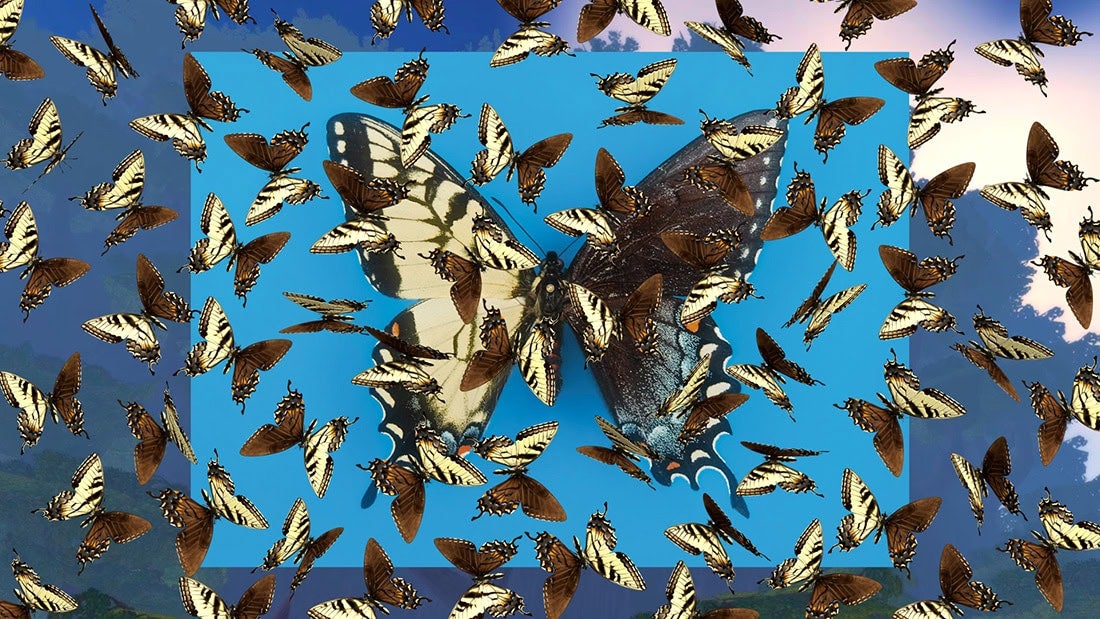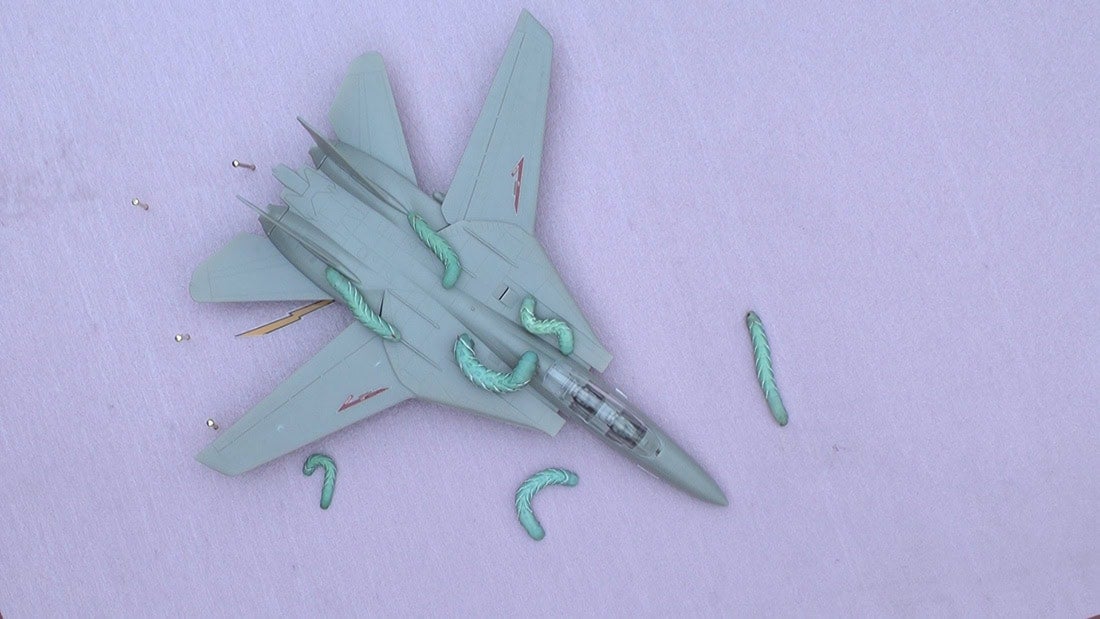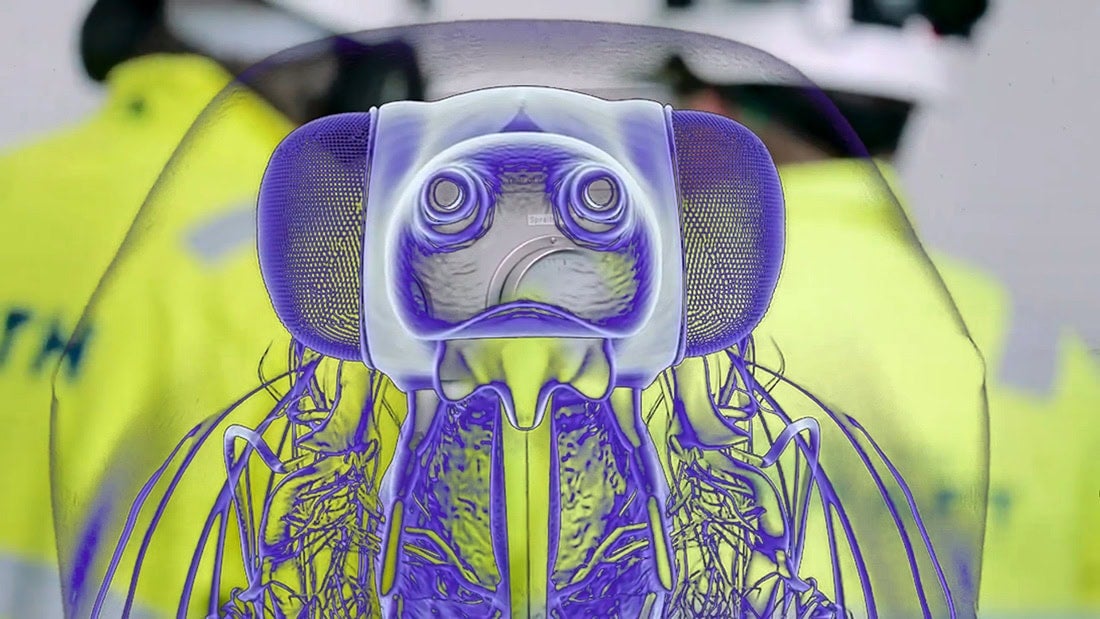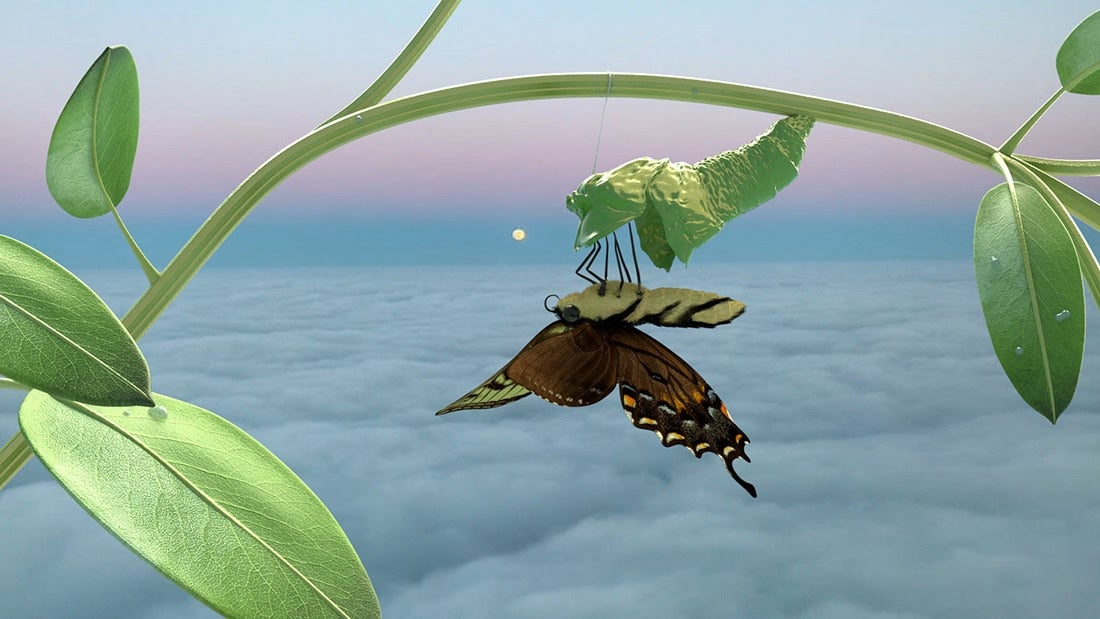
Bugs have always been indicator species. In the late nineteenth century, as England perfected the structures of industrialized labor subjugation that prefigured contemporary post-Fordist capitalism, a moth began to change its spots: the peppered moth, known for the delicately speckled patterning of dark pigmentation on its light gray wings. But, in the early decades of the twentieth century, a new colorway began to emerge—moths colored black, so as to better blend into the factory-polluted, soot-carpeted environments they then inhabited. This phenomenon of industrial melanism would, in turn, become a convincing proof of Darwin’s theory of evolution and the brutal systems of competition it evinced. Though the term readily invokes the racialized origins of plantation capitalism, it actually refers to the rapid evolution of pigmentation in response to environmental pollution—sulfur dioxide reducing lichen cover and soot darkening tree trunks. It is found primarily in sea snakes, some beetles, and butterflies.
We think of indicator species as harbingers of ecological catastrophe, but it’s worth remembering that all of our contemporary crises of labor and environment, genocidal and ecocidal, are inextricably interlinked in a global cybernetic system of deprivation, asymmetric though its effects are. This vast intermeshing undergirds the four-part video series Metamorphosis (all works 2020) released by the amorphous collective the Institute for Queer Ecology (IQECO). Taking its title from the process of a caterpillar’s total transformation into a moth or butterfly—a development known as holometabolism—the series launched online at DIS.ART in June and was featured in the film program accompanying the Guggenheim Museum’s exhibition Countryside, the Future. In each video, manipulated found footage is paired with voiceover by artist and performer Mykki Blanco. This narration tends to lean on dubiously elastic metaphor to advocate for a new view of nature that is not rooted in Darwinian theories of competition but rather “queerer strategies like symbiosis and co-evolution for intersectional collaborative survival.”
Here, the bug isn’t the canary in the planetary coal mine so much as a queer icon. Each video in this filmic proposal corresponds to one stage in the bug’s life: larval, pupal, and, finally, emergence from the cocoon. Serotiny (Prelude) sets the stage: wildfires, clear cutting, ever-evolving forms of colonialism, the prison-industrial complex, income equality, and so on—essentially the whole cast of Captain Planet baddies. Grub Economics takes up the baton with a broad, if rather vague, sketch of ecological thinking, revolutions, and petromodernity. (I’m reminded of another evolutionary icon, the Pokémon known as Metapod.) But these metaphors never actually harden, calcify, come into focus. This frustration pervades all four videos, though each offers its own interesting provocations.

Most compelling among these is the rather Matrix-like assertion that capitalism forces a kind of perpetual larval stage on people in which they are forced to endlessly consume and consume, like caterpillars bulking up for their pupal condition. With their insatiable appetites for leafy resources and capital accumulation, multinational companies are also compared to grubs. Throughout the work as a whole, there’s an emphasis on the rapaciousness of ever-more extractive capitalism, and a transposition of responsibility and accountability away from the individual and onto corporations—but instead of calling for accountability or, well, action of any kind, the videos instead advocate for moving beyond the pragmatism of current environmental politics to call for more imagination, more dreaming.
Liquidation in the Pupal Stage continues in the same vein, comparing the cocoon of power to various strategies of segregation and militarization, as CRT monitors featuring insects mummifying themselves glide like seniors on walkers across a highly artificial indoor-outdoor environment, the kind you might find at a budget spa. I think it is supposed to look vaguely Zen-like, but the wallpapered landscapes and painted ceilings pierced by multistory trees and faux-grotto-like water features remind me of shopping malls in the Arabian Gulf, raised as I was in the heart of the petropocalypse. There’s some fantastic footage of our hungry caterpillar hero, too, looking like a cross between an accordioned tube of peeled grapes and a spiny porcupine.
Things get satisfyingly gooey in the diagrammed description of what pupation, or cocoon-building, actually involves. Basically, an insect releases enzymes that dissolve its tissues like an acid bath, breaking its infrastructure down into clumps of cells, some of which form new structures called imaginal discs—a name that I suspect will be irresistible to the IQECO collective. “Liquidation does not represent erasure but, rather, redistribution,” we’re told as Blanco affably explains asset liquidation, before the narrative makes another grand poetic leap to reframe metamorphosis as a transition away from extractivism toward equitable access. Perhaps I’m just tired of the symbolic bankruptcy of vaguely solidaristic immaterial gestures and empty representation, but I begin to suspect that I’m too much of a pragmatist—and, perhaps, a pedant—for all of this.

We get a real life ecovillain in the mammoth West Australian Gorgon project, which developed one of the world’s largest liquefied natural gas fields at significant environmental cost. “Imagine what could emerge from liquefying the assets of the fossil fuel industry, or liquefying Monsanto,” Blanco’s narration offers. “Imagine all those juices.” The video advocates for what sounds like a new green-blue capitalism with all the enthusiasm of someone thinking about their lackluster packed lunch. I don’t know about you, but I don’t just want a world where I have some say over how to redistribute the oil and gas industry’s misbegotten funds into greener modes of capitalism, aggressive carbon taxation, progressive wealth taxes, and taxes on luxury goods. If we’re dreaming, entirely untethered from the practicalities of movement building and organizing, I’d much rather imagine a world without money, where the poor and otherwise marginalized people aren’t disproportionately penalized. Wouldn’t you?
Another model of failure is presented in the concept of diapause, or suspended development, dormancy and paralysis, and a failure to emerge. This is mapped to the impotency of the environmental movement as well as the stasis of queerness. It’s presented, convincingly, as a result of homonormativity in the coalitions forged during the Civil Rights Movement and the red, lavender, and green scares, the sort of commercialization best exemplified by corporate Pride but which also extends to queer spaces, questions of visibility, and the assimilationist impulse of same-sex cis couples. According to IQECO, this version of queer liberation requires economic liberation, specifically the Green New Deal. Which, sure—but it’s here that the limitations of a (North) American perspective, as well as uninterrogated slippages between federal and global registers, really stand out. Is there any economic liberation for non-Americans in this framework, or are they conceived of as the consumers of these new green American technologies and products?
While IQECO has (elsewhere) earnestly articulated a position of international solidarity that affirms the importance of creating and giving space to marginalized voices, actually considering the power differentials of the Global North seems to be off the table here. Indigenousness is occasionally referenced too in a manner that feels, like much else here, well-meaning but hollow. But while Metamorphosis never quite coheres in this realm, its central conceit—of queering ecology—is still worth engaging with. The last video in the series, Emergence, details the final stage in the bug’s metamorphosis, focusing on the gynandromorphic eastern swallowtail butterfly. The creature is unusual in that it both exhibits sexual dimorphism—males and females of the species exhibit different characteristics—and is also gynandromorphic, which is to say that it has both male and female traits. The result is a beautifully chimeric creature that is impossibly, perfectly split down the middle—a “bilateral gynandromorph”—with each wing showing a different patterning.

The narrator is careful here to emphasize that the appearance of these gendered traits is often unrelated to sex organs and, as such, should be understand more as expressions of gender. Moreover, this points to an infinite sense of queer potentiality that is only amplified when other species are considered: fungi, for example “have up to 36,000 sexes which make them interesting foundations for imagination to sprout from.” And while gynandromorphic butterflies in fact “fail” to lay eggs, this failure to perpetuate itself is a heteronormative—and by extension, capitalistic—misnomer. IQECO further draws analogues to reproductive justice or its lack, and the specter of “our future children” framing the control over people’s bodies—although they refer only to “women” here—as a labor strategy rooted in securing a future generation of exploitable workers.
The narrative can tend to feel heavy handed and didactic, even for someone who agrees with much of what IQECO has to say. Because so much information is crammed into each video, ideas are often referenced only shallowly and mostly introduced through disconnected non sequiturs, which can be especially frustrating when intriguing but less familiar concepts were introduced, such as heliosocialism or hydrosocialism. Despite a closing section on queer strategies for surviving and thriving, and the seductive buggy imagery throughout, the series’ total run time of around fifty minutes can begin to feel daunting. Maybe I’m expecting too much. I think of the fragments of text by José Esteban Muñoz that are read at the beginning of the Emergence video: We are not yet queer. We may never touch queerness but we can feel it as the warm illumination of a horizon imbued with potentiality. I wish it could be like that.
Metamorphosis, a video series by the Institute for Queer Ecology, is streaming on DIS.ART. Diapause, a work by Deidre Keough for the Institute for Queer Ecology, is streaming as part of ICA Miami’s Digital Commissions.




